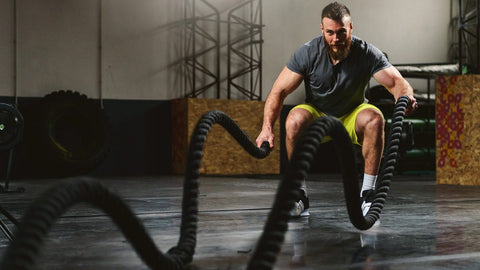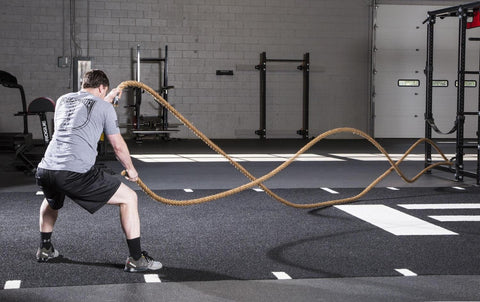Battle Ropes and Climbing Ropes – Choosing the Best Type for Your Fitness Goals
In the world of fitness, there isn’t just one type of all-purpose rope. Moreover, there isn’t just one rope length that can help ever individual reach their personalized fitness goals. As it stands, it is important to understand the difference between battle ropes and climbing ropes so that you can make an informed decision about which rope type you’ll add to your home gym.
Once you’ve learned the difference between these primary rope types, you’ll be ready to learn about the individual specifications – such as weight, material construction, and form – that make each rope type ideal for reach certain fitness goals. With these specifications in mind, you’ll be ready to take your rope-based workout to the next level by selecting a high-quality climbing or battle rope from Sparks Fitness Equipment.
 |
What Are Battle Ropes? You’ve almost certainly seen a battle rope before, in the hands of a professional-tier athlete as they work to build their strength and endurance. But as it turns out, battle ropes aren’t just some hunk of rope that that individual found lying about and improvised with. In fact, battle ropes a purpose-built piece of exercise equipment that is designed to stimulate muscle activity through varied engagement. |
Battle ropes are often a single long piece of high-gauge rope folded in half and held at each end by the user. Then, using a predetermined movement and length-based routine, the user thrusts the rope back and forth in a form of repetitive motion. This is generally used to help an individual increase their upper body strength while refining their cardiovascular endurance.
The best battle ropes are made in the United States from a variety of durable materials. Most general-purpose battle ropes are made from Dacron (such as these white battle ropes) while other users prefer the look and feel of more natural materials (such as these manila battle ropes).
|
Understanding Battle Rope Lengths, Widths, and Uses Most battle ropes are further differentiated based upon their length, width, and intended use. These first two factors as important to understand when purchasing a battle rope set because you cannot adjust the length or width afterwards without harming the rope’s structural integrity. |
 |
The length of your battle rope primarily effects the fluidity of its motion and its degree of resistance. The greater the amount of rope between you and the anchoring mid-point, the more effort you’ll need to exert to keep it in fluid motion. Also, length can be an important consideration if you are working in a compact space, as you’ll need half of the rope’s total length in spare room to properly exercise with a battle rope.

|
As for rope width, this metric can exponentially affect the overall weight of the rope. As such, a 2” wide rope is a fair amount heavier than a 1.5” rope. Also, thicker rope widths are harder to grip and are not recommended for those with smaller hand diameters (even if they are capable of handling the increased weight-based challenge). |
|
What are climbing ropes? Anyone who attended a public school during a certain period of time has certainly been made to climb a rope for physical education. While that may not have been the most enjoyable, rope climbing can be a particularly worthwhile full-body workout if you are using a purpose-built piece of equipment. Climbing ropes, at their core, are designed for this purpose. That being said, climbing ropes are not just made out of any old piece of scrap rope a gym has laying around. In fact, all professionally-made climbing ropes are designed to safely anchor the rope (and its climber) to a raised point (often the ceiling). This is accomplished with a bolted anchoring mechanism that secures the rope while still allowing it to hang lose in a natural manner. Like battle ropes, climbing ropes are primarily made out of natural and artificial materials, respectively. Dacron climbing rope (such as this black-colored model) are typically smoother, allowing new and experienced climbers alike to attain full grip without risking excessive rope burn. Some climbers prefer the resilience of manila rope, however, which is why manila climbing ropes are also widely available. |
 |
 |
Understanding Climbing Rope Styles and Uses Climbing ropes used for this type of physical fitness training generally come in two varieties: straight and knotted. Straight climbing ropes are, as their name implies, a single, continuous piece of rope (typically 1.5 inches in diameter) that is secured on a certified suspension system. By their nature, these ropes require an extra degree of experience and overall body conditioning to climb successfully. Knotted climbing ropes, on the other hand, feature simple knots across the rope’s full length (every 16” or so, in most cases). These knots act as an optional foothold for those looking to decrease the activitiy’s overall challenge. Those who are just breaking into rope climbing should practice and condition with one of these knotted models before moving onto their straight variants. Generally speaking, climbing rope length is up to the user’s discretion, as longer ropes only add greater challenge in terms of endurance. Those selecting between several climbing rope lengths should choose an option that fits their intended installation location. Longer ropes also place the climber higher off the ground, so those looking to upgrade to a longer climbing roper should also make safety adjustments accordingly. Which Type of Rope is Best? In the end, comparing battle ropes and climbing ropes is like comparing apples and oranges. Both are made from rope, certainly, but both are used for fully different types of exercise routines and can be used to reach differentiated fitness goals. If you’re looking to gain full upper body strength, a standard climbing rope is likely your best bet. However, if you’re looking to enhance a variety of muscle groups while also building cardiovascular endurance, a set of battle ropes should be your go-to. Regardless of which rope-based exercise equipment you decide to add to your home gym, be sure to choose an option that fits your level of fitness in order to ensure that you receive optimal physical fitness gains while reducing the risk for injury. |


